ALLIGATOR
BEHAVIOR page 5b: BABY
ALLIGATORS--page 2 page 1 3 4 5 6 7 8 9 10 11 12
This
page was born 9/08/2002. Rickubis designed it. (such as it
is.) Last update: 10/05/2022
Images
and contents on this page copyright ©2002-2022 Richard M. Dashnau
August
17, 2003Good
news! Another alligator nest was found in the park! While this
still isn't
as many as we'd like, it's better than just ONE nest. Also, one of
the
volunteers went to scout
out a good place to set a photo blind to catch
the hatching of the first nest (the one we found last week). When
he got
there, he saw the nest had been broken into, and there were
eggshells scattered
about. Fearing the worst, he and one of the Park
Naturalists
went to investigate the damage--where they were met by a
protective female
who had 17 baby alligators
near her. Yes! The eggs had hatched! Generally
alligator eggs don't hatch until the end of August in our park, so
these
alligators are a bit early. This all happened yesterday
(Saturday).
Today, I got to accompany Park Naturalist David out to the nest to
see
the babies, and perhaps find out if there were any eggs still in
the nest.
The picture above (KEEPING AN EYE ON
THE KIDS) shows the mother in front
of some of the babies (640
X 480 HERE). The babies are up on the bank behind her. We
were across
this small body of water, so she didn't perceive
us as a threat, although
she did turn to get a better look at us (see WHAT'RE YOU UP TO?,
below).
Trying to count baby alligators from 50 feet away is difficult
when they
are on a mudbank
and in dappled sunlight. Don't believe me? Take a look
at (COUNT 'EM, below). Then, we went back around and tried to
approach
the nest from her blind side (keeping the nest between
us and her). However,
when David got close, she lunged out of the water, and ran the 15
feet
or so from the water to her nest, where she stopped and watched us
(see
MY NEST, below).
Whether this was in defense of her nest, or of her already-hatched
babies was unclear. So, we left.
Remember,
female alligators will vigorously protect a nest. DO NOT EVER
APPROACH
AN ALLIGATOR NEST! First, it is dangerous; second, without
authorization,
it's illegal.
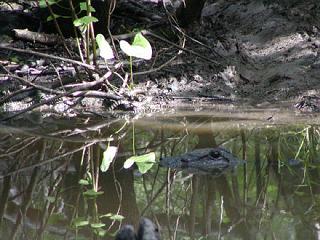 -
-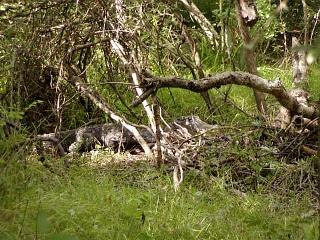 -
-
WHAT'RE
YOU UP TO?
MY NEST, YOUR
PAIN! (640
X 480 HERE)

CAN
YOU
COUNT 'EM? One
other
thing happened. Somehow, over the last week, I
turned 47 years old.
Oh, well. The babies tried to make my birthday.
August
07, 2003Finally,
we got to do a survey of alligator nests at the park. There were
only two
of us (Park Naturalist David Heinicke and I), and we had
difficulties getting
to where we
wanted to (LOTS of weeds, and the ARGO couldn't get to the
islands as we'd planned). No nest count was done last year,
although
at least 5 nests were seen and reported. The nests
reported last
year were all visible from areas that most visitors normally
travel. No
such nests were seen this year. We managed to inspect quit a few
islands,
though. This was fairly difficult,
considering we were wearing rubber waders
in 100-plus-degree heat, and had to to a lot of walking on land
through
underbrush (in the waders! Whew! HOT!). That is, once we got to
the
islands
in the first place. The heat also served to keep the alligators
not only
IN the water, but under it, or at least in the shade. So, while
wading
from island to island, we didn't see any,
although we heard two or three
splash somewhere nearby, unseen. In all the area we searched, we
only found
ONE nest. This is very unfortunate, and is probably due to the low
amount
of
rain the park has received this year(Claudette didn't give the
park
much rain); and the drainage of Pilant Slough last spring. The
picture
below (DON'T EVEN) shows the female guarding
the nest we found.
The red in her eye is from my camera flash. Even in daylight,
those eyes
will reflect light! While David cautiously approached the
nest closely
enough to get a GPS
reading, I stayed further back, and watched the area
between the nest and the water's edge. It didn't take long
for the
female to appear, and she was at least 7 feet long. She approached
the
shore, and then slid up out of the water, very quietly. Once she
spotted
David, (who was at least 10 feet from the nest on the landward
side-that
is on the opposite side from the female.),
she rushed to the edge of her
mound, with her mouth gaping. We both backed off, and she advanced
no further;
but just kept an eye on us. Seeing that we were not
bothering her
nest, she
closed her mouth, but still watched us carefully. We left. The
picture below (FEMALE) shows the nest with the female. Look how
large she
made the mound!
Remember,
female alligators will vigorously protect a nest. DO NOT EVER
APPROACH
AN ALLIGATOR NEST! First, it is dangerous; second, without
authorization,
it's illegal.
------------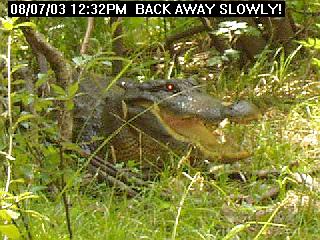 ----------------
----------------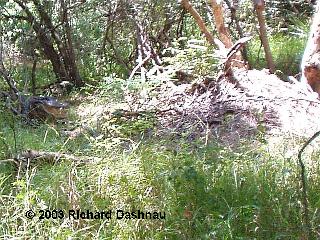 ----------------
----------------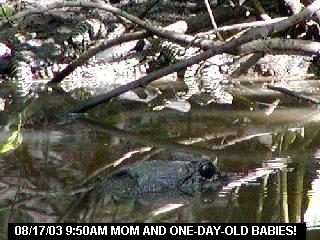 --
--
DON'T EVEN THINK ABOUT IT
FEMALE TO LEFT OF NEST
KEEPING
AN EYE ON THE KIDS
(640
X 480 HERE)
March
02, 2003Ok,
so
today was overcast, and kind of cool. I helped clear another
Elm Lake
island of plants to allow alligators to bask, and be seen
while they do
it. The day just seemed like
it would be one of those "slow animal
life days"--uncomfortably cool (to me), grey, and windy.
I decided,
around 3 o'clock, to head out and see if the nearby mother
alligator was
out. Well, as the
picture below (KIDS AND A SMILE) shows, she was!
Some of the young ones were also visible, which was
surprising. Yes, there
are four alligators in the picture. Two on her head, one in
the
right background,
and one visible directly between the heads of the two on the
mother's head.
By the way, the two on her head are "adopted", that is,
they aren't
hatched from her eggs. Below
(MOM AGAIN) is another picture of the
mother with her young. She'd moved some, and one of the babies
on her head
has moved to inside the curve of her tail. It was quite cool,
and I wonder
if the young ones climb on the mother in this weather because
she has been
gathering heat. She may be warmer than the water and the
surrounding air.
Something else to find out about, I guess.
----------------------------- ---------------------
--------------------- -
-
KIDS AND A SMILE
MOM
AGAIN
November
15, 2002For
the picture below (TOUGH MOM)I'm going back a few weeks. Ever
since the
high water, some animals in the park have had to move around a
bit.
One of them was a
female alligator that had made a nest on one of the islands
near the spillway trail. This "family" was visible from time to
time near
this nest on the shore of one of these islands. These islands were
submerged,
and the female and babies (the eggs hatched successfully!) were
forced
to come over near the trail. The female alligator will defend the
nest-and
after that, the babies-quite aggressively,
for about 2 years. So, this
female was forced to allow her babies up on the shore near the
trail. She
was always very close, and if anyone approached to closely to her
babies,
she'd hiss, and
otherwise make it known that she wasn't pleased. This was
noted, and the yellow "CAUTION" tape was place near the area to
warn people
of the situation. On this day (Nov. 10), I counted 15 young
alligators
scattered around. I thought this picture summed up the situation
well.
It's hard to see at this 320 x 240 resolution, but one of the
babies is
on the mother's back. Click here
to see a larger image.
------------------------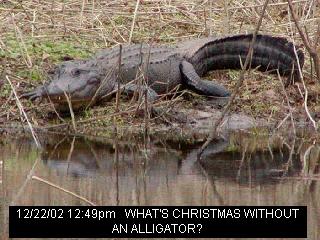 ------------------------------------
------------------------------------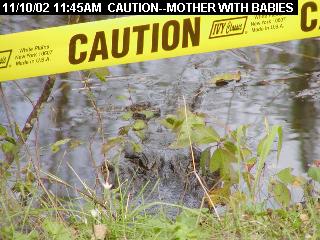
WHERE ARE THESE...REINDEER?
TOUGH MOM
September
08, 2002The
baby alligators that were released a week ago seem to be doing
fine, although
I only counted 7 of the new hatchlings (we'd released 8), and both
of the
yearlings (we'd released
two). The youngsters were out foraging, and swimming
around. The mother wasn't anywhere visible, but I assume she was
under
the boardwalk. (See 2 BIG AND ONE SMALL, GATOR PILE, and LITTLE
CHOMPER,
below.) Click on the links to see flv video clips of the little
alligators.
------------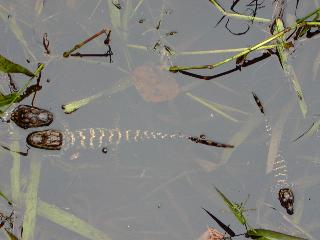 ---------
---------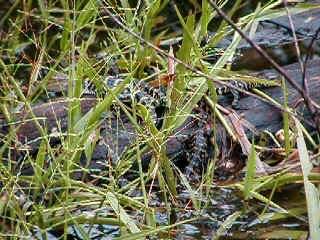 -------------
-------------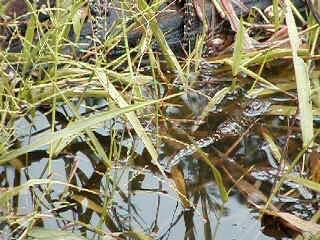
2
BIG AND ONE
SMALL
GATOR
PILE
LITTLE
CHOMPER
GATORPILE VIDEO
443KB
LITTLE
CHOMPER VIDEO 400KB
September
01, 2002The
image
below (SMILE!) shows me taking a picture of a snake that I found
on Elm Lake trail. The snake might be a yellow belly water
snake.
I'm taking this picture (and holding
the snake) because it appeared to
be injured in the head. The snake was very thin, and appeared not
to have
eaten for some time. A pair of park visitors took this picture
with their
camera and then were
nice enough to email it to me. The image below
left (HURT SNAKE) shows what I was taking a picture of while my
picture was being taken. I don't like to bother that animals
at Brazos
Bend State Park
unless it's absolutely necessary. This snake appeared
on the trail as I was hurrying back to the Visitor's Center.
Before I saw
the snake, though, and after I'd been photographing spiders, I saw
a LARGE
alligator on the trail. (See SPEED BUMP W/TEETH, below.) As I
approached
him, he got up and sauntered off the trail.( See THERE HE GOES,
below)
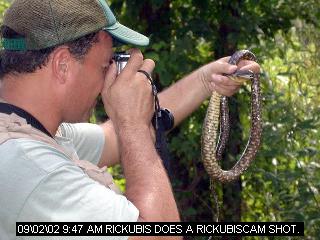 -
-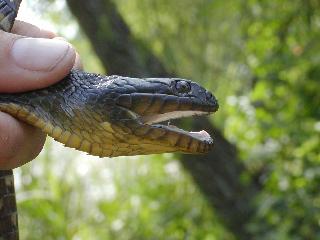 -
-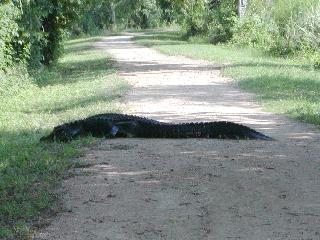 -
-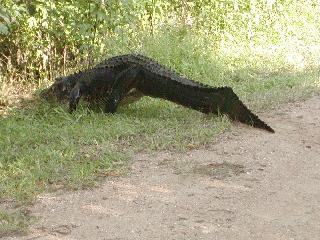 -
-
SMILE!
HURT
SNAKE
SPEED BUMP WITH TEETH
THERE HE
GOES
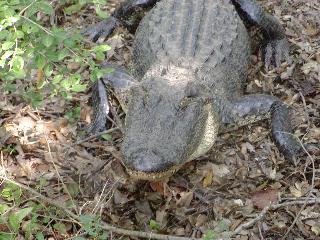
UH,OH! THE
BIG MOM!
Around
10:00 am, that Sunday, we gathered together to release the
week-and-a-half
old alligator hatchlings. The plan was to lure one of the
mother
alligators in Creekfield lake (one of those that
had nested there), and
then release the babies to her.
First,
we tried the larger nest, the one I've pictured before. The female
who'd
made this nest was very large, around 8 feet long. We
carefully
approached
the nest, but the female hadn't been seen near it for at least a
week.
I assumed/hoped that the eggs had hatched, and she had left with
the young.
David began playing a recording of
young alligator chirping. There was
no response. So, since there were so many of us to look out for an
angry
mother, David decided to inspect the nest. He found that it was
filled
with eggs. He took
one out, and noticed some odor. When he broke this egg
open, nothing but egg contents (undeveloped, that is) came out. It
was
infertile. He took out another and opened it. Inside was a
fully
formed
baby...dead. What a great disappointment. The young one looked
like
it was within days of hatching. The nest had apparently been
flooded during
the rainstorm that made the removal of the other
eggs necessary. However,
this one had probably flooded overnight, and although briefly, it
was long
enough to suffocate the eggs. There was nothing that could have
been done
any differently. The
eggs were thought to be safe, and the mother was large,
and had been aggressively guarding her nest. We were all saddened
by this
discovery.
However,
we had better business to attend to...the live babies. So,
we went
to the long pier, and the nest where the eggs had come from. We
spread
out along the boardwalk and the deck at the end
(well I was there).
David again played the chirping. I think we waited for about 10
minutes,
and then I saw the mother approach from the far end of the pier.
She came
straight in without hesitation.
I sounded the alert, and then we all watched
for her. The last place David needed to be was near the
nest, and
the babies, when the mother got close. So, we watched. John
saw her
next, as she
poked her nose out from under the pier. She'd traveled under
the boardwalk until she was close to the nest. This was
still about
20 feet away.
Then,
she started moving towards the nest. David released the babies
quickly
and gently, and moved away. The female slowly approached and we
watched--I
think we were all worried--as the
mother got close to the babies.
Would she eat them? Turn and leave? Here are 3 video clips that
show what
happened. Click the links below the three pictures (nest 2a, 2b,
2c) to
see the clips.
---- -----
-----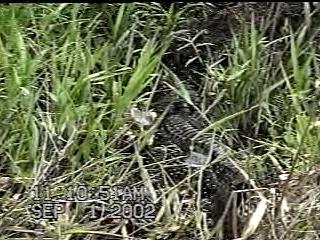 ----
----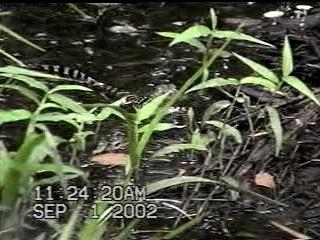 -----
-----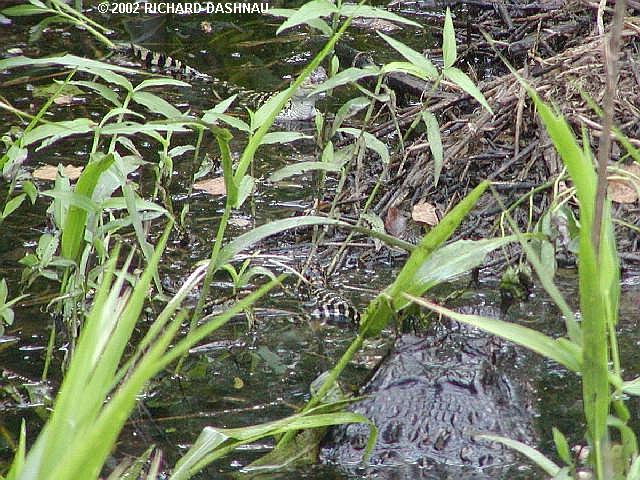
NEST
2A
(608KB)
NEST 2B (854KB)
NEST 2C (683KB)
THE MOTHER AND BABIES(640 X 480)
MPEG
NEST
2C (2492KB) ONLY THE
LAST CLIP IS
ALSO IN MPEG FORMAT.
She
did neither. She just started mothering, alligator-style. She
seemed to
move around, to allow the young to see her. Some of the
babies were
on the far side of the nest from her, and although it
was very low, she
would not climb up onto it. She could hear the babies on the other
side
(by the way, once her presence was known, all the babies began
chirping.
What a unique sound! It
sounded like a little battle taking place with
ray guns.) Also blocking her way were two logs, which she
also would
not climb over. She finally was able to go under them, and look at
the
babies over
there. Generally, when the young alligators saw her, they would
move towards her. Then, she began pushing the logs away, and
generally
clearing a space around the nest. She stationed herself
in this cleared
area, and submerged herself, leaving just her head exposed.
We watched
for about 30 minutes. I was happy with the results. The young were
reunited
with their mother! But...the
drama had yet another act to follow.
Around
4:00pm, I decided to go by one last time, to check on the mother
and the
babies. When I got there, I saw that Glen had set up a spotting
scope and
tripod on the boardwalk for inspection
of the nest. While I was there,
he packed up, and left. For some reason, a large number of
park visitors
started appearing on the Creekfield trail. There were about 8
people on
the boardwalk, and
I was talking about alligators (I bet that's
a surprise to some of you! Or not. Ha ha ha), when one of the
visitors
exclaimed something like " Holy cow! There's a huge alligator on
the trail!
" I quickly
moved to the land ward end of the boardwalk, and yes,
there was a large alligator there! (See, UH, OH, THE BIG MOM
above)
Of course, all the visitors wanted to see it, but this alligator
was right
next to the only way off the boardwalk. I asked them to stop
moving, and
I moved towards the alligator...and she hissed. "Ok." I
said, " Everyone
move back and give it some room." I guessed that
this was the large female
whose eggs we'd discovered were dead that morning. Why she
came from
uphill, towards the observatory, was a mystery to all of us.
I supposed
that she was
responding to the chirps from the baby alligators, though.
She got up and moved under the boardwalk, then came out the other
side
and took a few steps towards the nest and babies. The two
females were
at least 20 feet apart, and separated by grass and vegetation.
But, I still
believe they were aware of each other. The newcomer turned and
went back
under the boardwalk. Sometime
during this, Glen returned with the spotting
scope, and set it back up. More park visitors appeared. While we
were answering
questions, the large female (if that's who she was) gave one
loud,
short
growl. Then, a little later, she could be seen skulking around at
the end
of the pier, under the wide deck. Her nose was pointed directly at
the
nest and other female. I left then, to go home.
For
those who are wondering, I returned the following Monday, and
found the
mother and her babies peacefully lying around. I saw no sign of
the larger
alligator.
-----
And,
this page shows alligators at the park, on
land, near various landmarks at the park.
Go back to my main alligator
page, Alligators
Go
back to my home page, Welcome
to rickubis.com
Go
back
to the RICKUBISCAM
page.
Go
back
to the See
the World page.
 -
- -
-



















